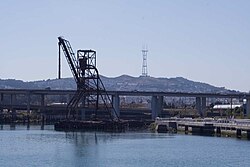| Islais Creek | |
|---|---|
 Islais Creek with an abandoned five-story-high copra crane,[1] Interstate 280 and Sutro Tower in the background | |
 | |
| Etymology | Los Islais, Spanish and slay or islay, Salinan (Native American) for Prunus ilicifolia wild cherries[2][3][4] |
| Location | |
| Country | United States |
| State | California |
| Counties | City and County of San Francisco |
| City | San Francisco |
| Physical characteristics | |
| Source | Cesar Chavez Street |
| • location | Near Potrero Hill, City and County of San Francisco, California |
| • coordinates | 37°44′51″N 122°23′16″W / 37.74750°N 122.38778°W[5] |
| • elevation | 1 ft (0.30 m)[6] |
| Mouth | San Francisco Bay |
• location | Near Bayview-Hunters Point, City & County of San Francisco, California |
• coordinates | 37°44′54″N 122°22′32″W / 37.74833°N 122.37556°W[5] |
• elevation | −10 ft (−3.0 m)[5] |
| Length | 1 mi (1.6 km)[5] |
Islais Creek[pronunciation?] or Islais Creek Channel (previously known as Du Vrees Creek, Islais Channel and Islais Swamp)[7] is a small creek in San Francisco, California. The name of the creek is derived from a Salinan Native American word "slay" or "islay", the name for the Prunus ilicifolia wild cherries. Around the time of the Gold Rush, the area became an industrial hub, and the condition of the creek worsened. After the devastating 1906 San Francisco earthquake, the city decided to reclaim the creek using earthquake debris, reducing the waterbody to its present size. Though much of Islais Creek has been converted to an underground culvert, remnants still exist today at both Glen Canyon Park and Third Street. Several community organizations are dedicated to preserve these remnants, as they are important wildlife habitats.
- ^ Jeanne Alexander. "Islais Creek History". National Park Council. Archived from the original on May 9, 2008. Retrieved May 25, 2008.
- ^ Ron Sullivan (December 7, 2002). "Roots of native names". San Francisco Chronicle. Retrieved November 3, 2007.
- ^ E. G. Gudde (1946). "The Solution of the Islay Problem". California Folklore Quarterly. 5 (3): 298–299. doi:10.2307/1495525. JSTOR 1495525.
Gudde concludes that the word "islay" originated in a Salinan word slay; Islay was the Spanish version of their word
- ^ Pearl Winaker; Bernard C. Winn. "History of Islais Creek". islaiscreek.org. Retrieved May 25, 2008.
- ^ a b c d "Islais Creek Channel". Geographic Names Information System. United States Geological Survey, United States Department of the Interior. 2000-06-14. Retrieved December 10, 2007.
- ^ Source elevation derived from Google Earth search using GNIS source coordinates.
- ^ According to the Geographic Names Information System by USGS, other lesser known variant names for Islais Creek or Islais Creek Channel include Arroyo Islais, El Arroyo De Los Yslais, Islar Creek, and Du Urees Creek.